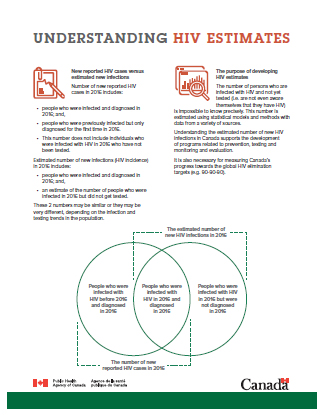Understanding HIV estimates

Download the alternative format
(PDF format, 159 KB, 2 pages)
Organization: Public Health Agency of Canada
New reported HIV cases versus estimated new infections
Number of new reported HIV cases in 2016 includes:
- people who were infected and diagnosed in 2016; and,
- people who were previously infected but only diagnosed for the first time in 2016.
- This number does not include individuals who were infected with HIV in 2016 who have not been tested.
Estimated number of new infections (HIV incidence) in 2016 includes:
- people who were infected and diagnosed in 2016; and,
- an estimate of the number of people who were infected in 2016 but did not get tested.
These 2 numbers may be similar or they may be very different, depending on the infection and testing trends in the population.
The purpose of developing HIV estimates
The number of persons who are infected with HIV and not yet tested (i.e. are not even aware themselves that they have HIV) is impossible to know precisely. This number is estimated using statistical models and methods with data from a variety of sources.
Understanding the estimated number of new HIV infections in Canada supports the development of programs related to prevention, testing and monitoring and evaluation.
It is also necessary for measuring Canada’s progress towards the global HIV elimination targets (e.g. 90-90-90).
Range of uncertainty around HIV estimates
Uncertainty can arise in developing the estimates due to the incompleteness of the available data. For example, non-HIV-related deaths among HIV-positive persons are not well captured by vital statistics registries. As well, it is not always possible to know whether one HIV positive person has been counted twice among the number of people diagnosed with HIV, since a person could have been tested anonymously and then again using their name (nominally). As a result, the estimated numbers have wide ranges of uncertainty around them.
Although we cannot be sure whether the true number is equal to the estimate, we can be fairly sure that the true number lies within the range of uncertainty around the estimate.
Revisions to historical estimates
It is true that estimates for previous years change over time. As an example, the estimated number of people living with HIV in Canada in 2014 is noted as 60,165 in the 2018 report. However, in the 2016 report, the estimated number of people living with HIV in Canada in 2014 is noted as 65,040. This difference is due to the following two factors:
- Updated surveillance data were available for the work done for the 2018 publication that were not available for the 2016 publication. For the 2018 publication, most provinces and territories were able to remove HIV cases that were infected with HIV outside of Canada, or had been previously diagnosed with HIV in another province/territory. As well, some provinces and territories were better able to remove duplicate cases.
- Improvements are incorporated into the methods based on the latest available science and understanding of the epidemic. This has allowed the Agency to more accurately estimate the number of new infections and those living with HIV in Canada.
This is why revised historical estimates are included in the most recent publication, enabling a more accurate description of trends over time.
Other international organizations such as the European Centre for Disease Prevention and Control, US Centre for Disease Prevention and Control, Public Health England, UNAIDS, and the Kirby Institute in Australia also produce HIV estimates that include uncertainty ranges and revise previously published HIV estimates based on updated data and new methods.
For example, UNAIDS estimated the number of new global HIV infections in 2017 to be 1.8 million with a range of uncertainty between 1.4–2.4 million.
In 2015, Public Health England published an estimate of 103,700 people living with HIV in the United Kingdom (UK) in 2014. Then in a 2016 publication, this estimate was revised to be 97,610 people living with HIV in the UK in 2014.
For more information, please consult the full report - Summary: Estimates of HIV incidence, prevalence and Canada’s progress on meeting the 90-90-90 HIV targets, 2016